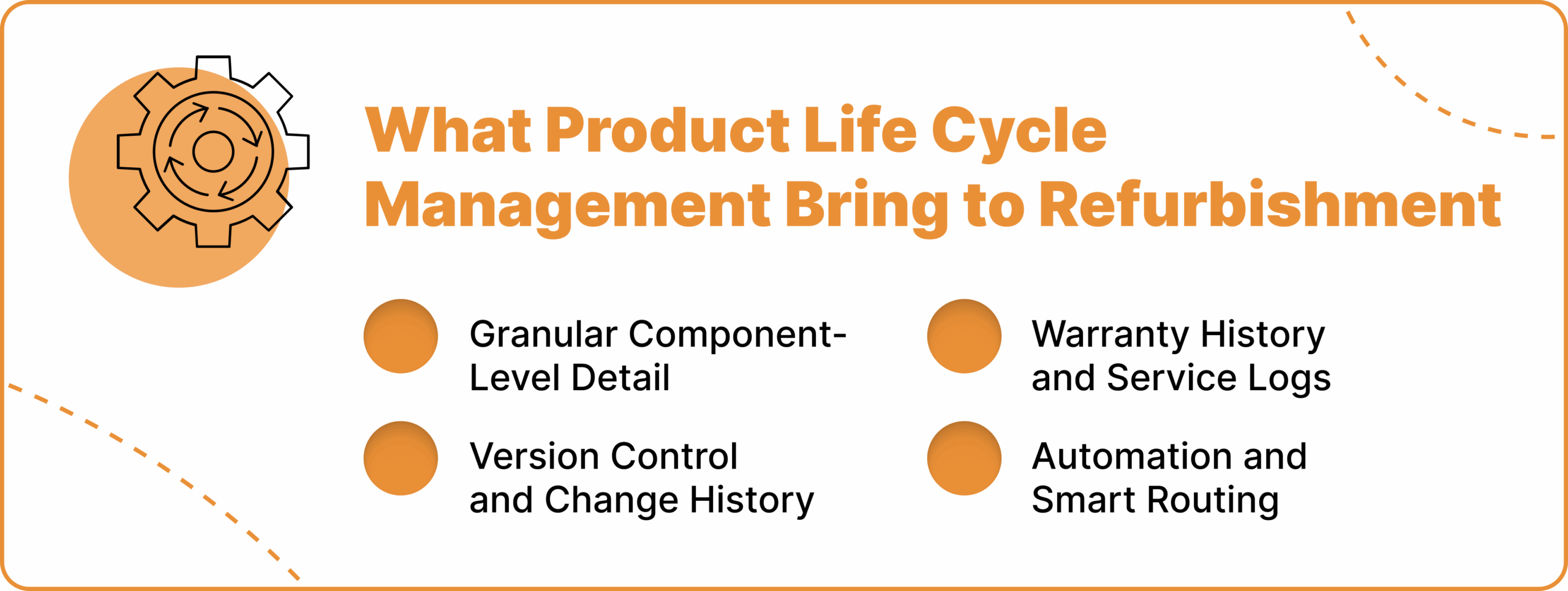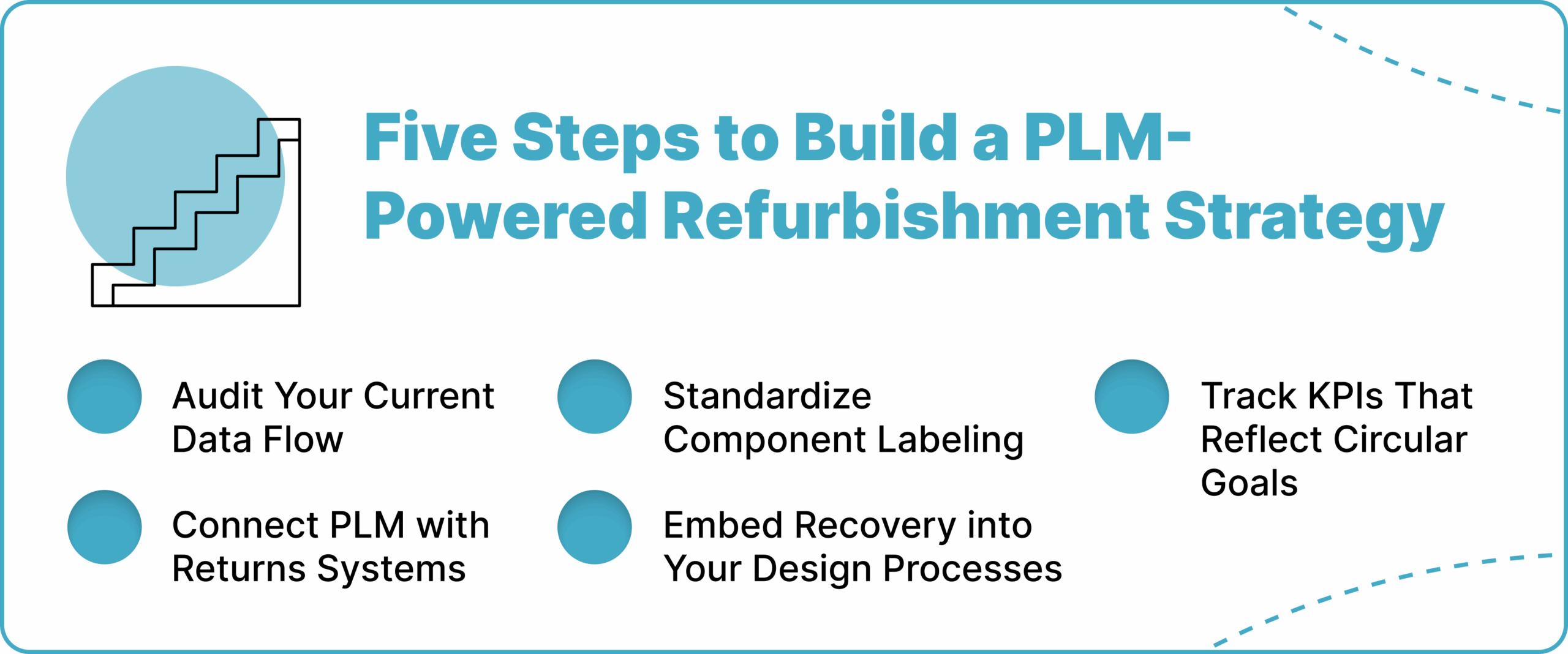Product Data Management for Refurbishment: PLM’s Critical Role

Despite advancements in technology and product data management, retailers and manufacturers still treat refurbishment as a physical task, not a data one. It is a mistake that wastes time, kills resale value, and weakens brand trust.
Refurbishment is only efficient when powered by structured, accessible, and accurate product data management. The repair technician, the warehouse sorter, and the return gate all rely on the same thing: knowing what the product is, how it was made, what changed, and what it needs now.
Product life cycle management must support the entire reverse supply chain process, from intake to resale, through accurate, detailed data. And in this article, I will show you why.
Refurbishment Is Booming. But It’s Built on Broken Systems
Refurbishment is growing because demand is shifting. More than ever, customers want value, speed, and product quality. But they do not want the price tag. Nevertheless, that trend is powering resale markets, return-to-retail programs, and warranty-backed recommerce.
However, most returns today still move through manual logistics processes. And refurbishment decisions are based on guesswork, not history. Lack of structured product data makes triage slow and repairs risky.
According to the National Retail Federation, product returns reached $743 billion in the U.S. in 2023. A large portion came from faulty logistics, unclear warranty status, or incomplete engineering data. Much of it could have been saved—if the return process had better data.
Data Gaps Kill Refurbishment Speed and Trust
Most refurbishment delays start with missing or outdated product related data. Workers often can’t verify model specs, check change logs, or track part compatibility. These data gaps slow down the reverse logistics processes, create bottlenecks, and lead to poor repair calls.
Manufacturers and retailers lose resale value when they:
- Make repairs with the wrong parts
- Miss a software or firmware update
- Restock components that are out of date
- Can’t verify if the product is eligible for warranty-backed resale
All of these is possible when the engineering processes, support teams, and repair staff don’t share a single source of structured product data. Without a connected PDM system, repair teams lose time searching, ordering, or validating.
What Product Life Cycle Management Bring to Refurbishment

The PLM system doesn’t just serve engineers. It serves every team that handles a product across its life span. That includes the teams managing its return, repair, and resale.
Here’s what effective product data management software delivers in refurbishment workflows:
1. Granular Component-Level Detail
Repair accuracy depends on knowing each part’s specifications. A strong PLM gives access to bills of materials (BOMs), CAD tools drawings, part versions, and firmware levels. This ensures technicians replace or reflash parts correctly—even across multiple product generations.
2. Version Control and Change History
Products evolve, new materials get used, and firmwares gets patched. Without tracking change orders, your repair decisions become risky. A PLM-powered workflow tells you if the returned item matches the latest supported version or if it needs special handling.
3. Warranty History and Service Logs
PLM data, combined with service records, allows instant validation of warranty eligibility. It shows if the item was previously repaired, how it failed, and what parts were used. This reduces returns fraud and speeds customer handling.
4. Automation and Smart Routing
Structured data supports AI-powered triage. When a returned item’s serial number is scanned, smart systems decide: repair, recycle, or restock. This removes human bottlenecks and improves returns management.
Reverse Logistics Integration Starts with Product Data
Reverse logistics refers to the supply chain flow that starts after the sale. But it should not begin after the design. It should begin during the development phase where PLM lives. When PLM connects to reverse workflows, you unlock:
- Real-time condition tracking of returned items
- Audit-ready documentation for every unit recovered
- Part-level routing to the correct repair or discard flow
- Structured decision trees based on component age or failure history
Imagine a company receiving 1,000 returned smartwatches. Without data, they will have to check each one manually. With PLM + reverse logistics integration, the system flags 300 for repair, 200 for recycle, and 500 for resale—with tags ready to print.
That’s not just better repair. That’s efficient supply chain management.
Component Traceability Builds Recommerce Confidence
Buyers of second-life or second hand goods want assurance. They want to know the item has been validated, repaired, and supported by the original specs. But to offering that trust depends on traceability. Component traceability means you can track a part from manufacturing to resale.
It shows:
- When it was installed
- If it was ever replaced
- Which version it carries
- If it’s still under warranty
Component traceability gives your reverse logistics team the confidence to approve a resale. It gives your project managers and stakeholders the data to justify recovery goals. And it gives your brand a reputation for product quality and control. But more critical is that it also gives your buyers peace of mind.
Five Steps to Build a PLM-Powered Refurbishment Strategy

Building an efficient refurbishing operation starts with connecting data across the product’s full life cycle. Here’s how to begin:
1. Audit Your Current Data Flow
Identify where data lives. Do repair teams access product data from the same system as engineers? Are BOMs version-controlled? Are firmware logs attached to serials?
2. Connect PLM with Returns Systems
Use middleware or direct API connections to sync your PLM with returns management and enterprise resource planning tools. Ensure data travels with each returned item.
3. Standardize Component Labeling
Use serialization to tag parts at the factory. Standardize metadata: model, firmware, usage class, and warranty expiration. This reduces errors in sorting and speeds diagnostics.
4. Embed Recovery into Your Design Processes
Plan for refurbishment during the development process. Create design data that supports recovery: modular layouts, easier disassembly, and reusable packaging.
5. Track KPIs That Reflect Circular Goals
Move beyond return rate. Track part reuse rates, repair cycles, resale ROI, and customer loyalty tied to refurbished programs. These metrics drive lasting efficiency.
Refurbishment Can’t Run on Guesswork
Speed matters in forward logistics. But in the reverse process, precision matters more. Which is why without accurate data, you delay repairs, discard recoverable goods, and lose trust with buyers and partners. Refurbishment only works when product data works first.
A company that manages engineering data, design changes, and warranty logs in a single system recovers faster, sells smarter, and cuts logistics costs across both forward and reverse flows. The brands that lead in recommerce are the ones that stopped treating data as an afterthought. They made it the engine.
Conclusion: Structured Data Is the Foundation of Scalable Refurbishment
To make refurbishment work at scale, you must control the data behind the parts, not just the parts themselves. PLM systems, integrated with reverse logistics processes, create a loop that saves money, reduces waste, and builds trust. They allow companies to act on real service history, not assumptions.
ReverseLogix is the only end-to-end return management system that lets you initiate returns, configure return processing, and even handle repairs. By bringing it into your product life cycle management early, make your supply chain much more flexible and robust. The companies that win tomorrow are designing for the return—today. Get a demo today.
That’s how you move from return chaos to recommerce at scale. Not with more people. Not with more tools. With better data.
Frequently Asked Questions
CAD data provides exact measurements, materials, and tolerances for every component in a product. When used in PLM systems, CAD files guide technicians through disassembly, help them identify the correct replacement parts, and reduce errors during refurbishment. This improves both speed and quality during reverse processes.
Yes. PDM software centralizes product-related data and engineering change records, which supports better reuse decisions. By keeping accurate documentation throughout a product’s lifecycle, companies reduce unnecessary discards, repair smarter, and extend the life span of returned items.
Collaboration ensures that engineers, warehouse teams, and returns processors access the same up-to-date product data. This includes design specs, warranty rules, and change logs. A well-integrated PDM system streamlines this collaboration, which is essential for consistent decisions across the refurbishment cycle.
Without a plan for managing the flow of returned items, companies face bottlenecks, rising costs, and inconsistent repairs. A solid reverse logistics plan—built with traceable data and system integration—ensures that recommerce operations stay efficient, cost-effective, and scalable.
Project managers get full visibility into post-sale activity, including return volume, service failures, and warranty claims. Reverse logistics integration lets them make informed decisions during early product development, helping align design decisions with real-world failure data.
